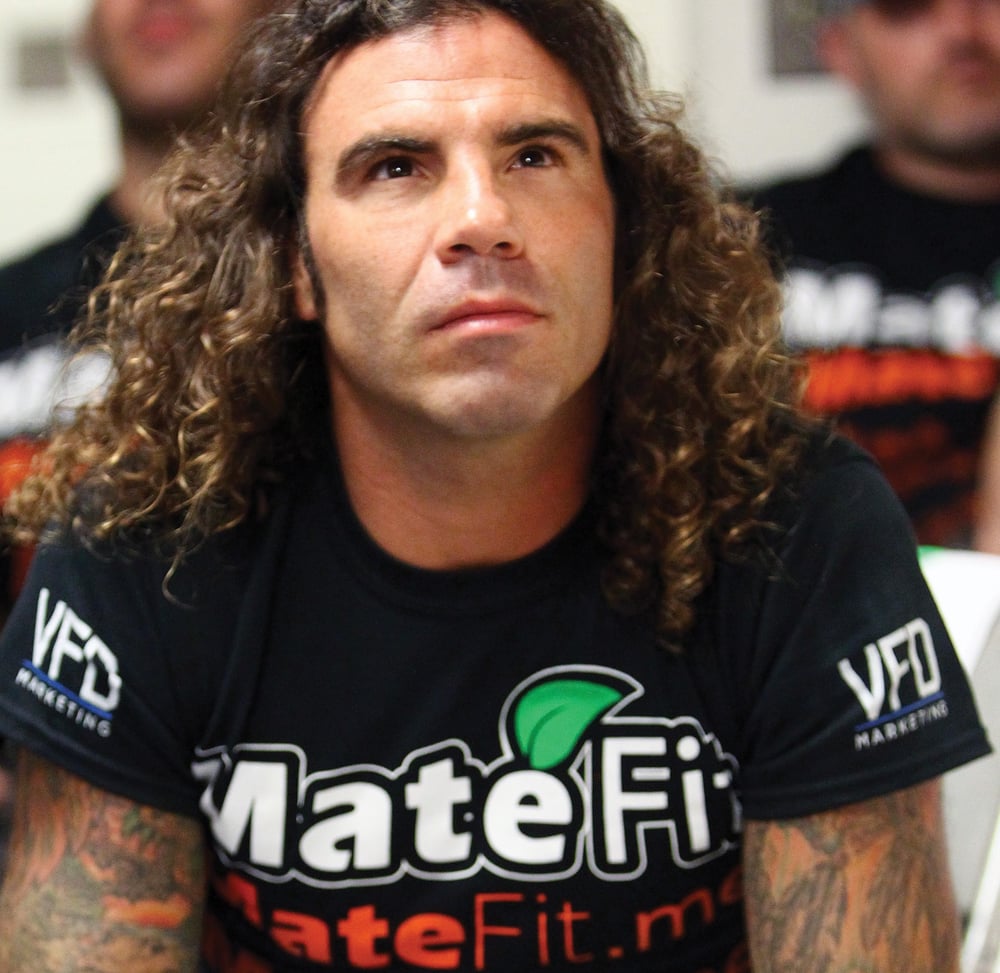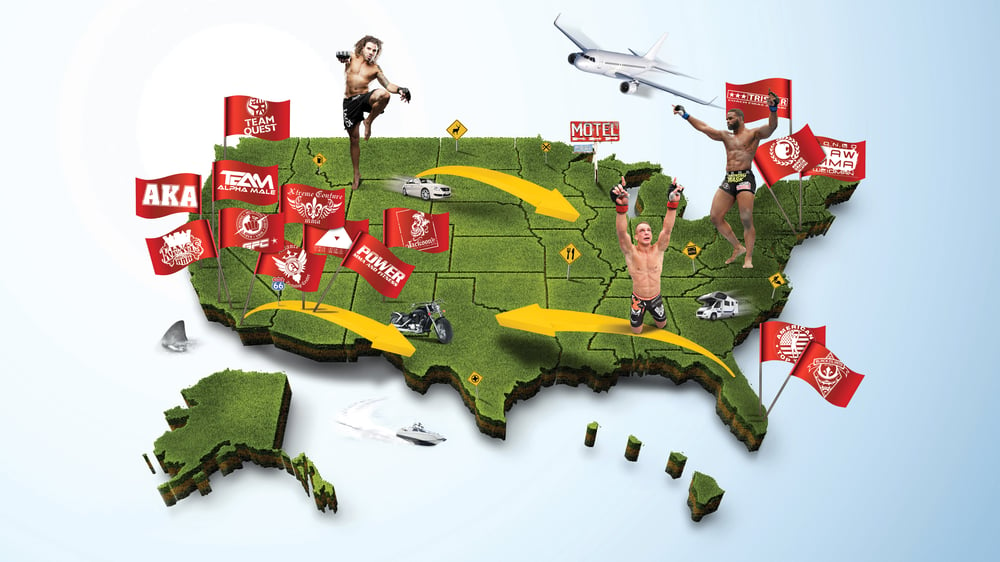
Issue 132
September 2015
The days of MMA’s finest solely training at one camp are a thing of the past, but why are some of the best fighters in the sport being coached on the road? FO investigates...
Mixed martial arts has always been a constantly evolving sport where concepts, training methods and philosophies are replaced by fresher, newer and more efficient methods as athletes strive to reach their full potential.
However, as the sport has grown and more fighters with a variety of high-level skills are drafted into the biggest promotions in the world, it’s become increasingly difficult for them to get the training they require solely from the training center they traditionally call home.
While many fighters still feel a strong sense of loyalty to certain gyms, coaches and sparring partners they work with every day, others are taking a road less traveled by following in the footsteps of competitors like former UFC welterweight and lightweight champ BJ Penn.
Before he became one of the best fighters to ever compete inside the Octagon, ‘The Prodigy’ left his home town of Hilo, Hawaii, to learn the techniques that would not only make him a threat on the ground but everywhere else too.
His quest for mixed martial arts perfection took him to California, where he trained at the American Kickboxing Academy in San Jose. He also flew to Rio de Janeiro, Brazil, where he spent time on the mats at Nova Uniao and earned his Brazilian jiu-jitsu black belt from esteemed coach Andre Pederneiras.
Until recently, gym hopping was far from the norm, but today many fighters are doing something similar to the former two-weight UFC champion by not just sticking to one location, but traveling to new camps in the hope they’ll get the best possible training, often bespoke to an upcoming opponent.
Fighters Only spoke to some of MMA’s most high-profile wandering warriors to discover why they’ve decided to pack their bags and leave their comfort zones in hopes of fight-night glory.
Have gloves, will travel
With hundreds of quality MMA gyms spread across the planet there’s never been a better time in the sport’s double-decade history that would allow professional athletes to have their pick of where to dedicate a training camp.
However, it’s a decision that’s much more than a matter of chasing the sun, sea or sand. Any new destination must first and foremost offer something their current facility cannot, whether it’s new coaches, improved sparring opportunities or simply a more cost-effective approach to training.
Leading UFC welterweight contender Tyron Woodley is one athlete who’s taken his fight camp on the road over the years, and he believes picking the right environment to hone your skills will yield the best results when it’s time to step into the cage.
“Training at different gyms benefits me because I’m not doing the same training for every fight, because every fight is different,” he says. “I might be fighting a guy that’s a boxer, so I might relocate to Los Angeles or Hollywood for the boxing. When I fought Jake Shields and Nate Marquardt, I did my entire camps at ATT in Florida.
“The only gym I haven’t been to is Greg Jackson’s because GSP (Georges St Pierre) was there at the time and Carlos Condit. Before I retire, I’d like the opportunity to train with some of those guys, which I look forward to. I’ve also never been to Power MMA, and that’s a pretty good gym too.
“My choice of gym really depends on who I’m fighting, what they bring to the table and who can put me as close to that style of fighter as I can get.”
For some fighters, looking into training at a different gym is less about preparing themselves for a specific opponent and more about pushing their training to the next level. After suffering a close unanimous decision loss to James Vick last November at UFC Fight Night 57, German lightweight Nick Hein decided he needed to take his training up a notch.
‘Sergeant’ made the 5,579-mile trip from Cologne to Phuket, Thailand to ensure he got the training that helped him secure victory against Lukasz Sajewski at UFC Fight Night 69 in front of his countrymen in Berlin. It was a decision he didn’t take lightly.
He says: “I was a police officer for 11 years and that caused some troubles because I’m the first German police officer to fight in the UFC. There has never been one before so it was new for them. Also, the sport in Germany is still... People don’t know what to think about it. We’re way behind in the development of the sport.
“I had to quit my job and I knew I had to make a decision. If I want to go on – and I’m not the youngest, let’s be honest – then I needed to change and be 100% committed. That made me look for opportunities.
“I was talking to Urijah Faber, I talked to Dan Hardy, I spoke to Luke Barnatt... I was even talking to Team Takedown in Texas. I was thinking of moving there and I was willing to do anything. Nonetheless, I chose Thailand and moved to Tiger Muay Thai in Phuket in the end.”

Perpetual motion
Clay Guida built his reputation as an all-out, non-stop lightweight contender under the tutelage of the coaches at Jackson-Wink MMA in Albuquerque. The Illinois native has spent the best part of a decade in New Mexico, but this year took his training on the road to reinvigorate his approach.
He’s traded life in the ‘Dudemobile,’ the pimped-out Winnebago that was parked on a reservation next to a lake just a few miles from the gym, for an apartment on the California beachfront in order to train with a new set of coaches and sparring partners.
‘The Carpenter’ worked his standup at Glendale Fight Club in the Valley, and rolled on the mats with the diminutive dynamos at Team Alpha Male in Sacramento. And following his points victory over Robbie Peralta in April, he admits the move refreshed his approach.
He says: “I’ve always traveled and trained all over. I like getting about in my Winnebago and love hitting the road. I love cruising around and fishing, going to music festivals. It’s part of who I am inside and outside the Octagon. Greg Jackson calls it my perpetual motion.
“This year I needed a fresh start. What I love about Jackson’s is that it’s one big family, and on any given day you can have between 10 and 20 different training partners. But I had to get out and hit the road, mix it up a little.
“I’ll always consider everybody at Jackson’s as family and I know one day I’ll be back there training with the guys again. But right now I’m out here in sunny California, living by the beach and enjoying the lifestyle.
“I’m also enjoying learning new things with my hands. I’m really enjoying the boxing up at Glendale. And I’m also down at Team Alpha Male regularly too, which is a gym that speaks for itself. I’m friends with all the guys down there anyway, and it’s a melting pot of the very best little guys in the sport so I love it.”
Guida admits leaving coaches of the caliber of Greg Jackson and Mike Winkeljohn was tough, but he moved on with their blessings and again reiterates how the door to the gym will never be closed. To him at least.
“I owe so much to Mike Winkeljohn, Greg Jackson, Brandon Gibson, Mike Valle; they’ve taught me so much. And they’ve told me that I can go back any time. It’s an open door for me up in New Mexico for sure,” he says.
“They’ve got my best interests at heart, as a friend, as an athlete and as a family member. They understood that I need to get out and mix it up a bit and; as I said, get a fresh outlook on things.”
The best laid plans
Taking a training camp to a place where an opponent’s specific skills can be highlighted and tackled can be a tempting idea for any fighter. After all, as the sport grows the amount of money to be won increases, making each bout significantly more important.
However, all the planning and research a fighter does before finally picking the gym they’re going to be working at means nothing until they actually set foot on the mats, as Woodley discovered at one gym on one of his trips.
“I went to California once and I was led to believe that it was organized, everybody was focused and there were so many training partners who were really going to prepare me for a fight,” he recalls. “When I got there, there was hardly anybody there and the training facility they had moved to was very small and one of the coaches was in Mexico.
“They weren’t really focused, they were just lollygagging and going through the motions. I stayed for a couple of days and then I said, ‘Alright, man, I’m out.’ I packed up and went back home.”
He adds: “That’s the good thing about having your own gym, I know exactly what I have. I can fly people in to me, which I’ve done for many, many years.”
Unwelcome visitor
Another problem that can rear its head when a fighter is gym hopping is being matched with an opponent that was once a training partner and possibly a friend. It can prove to be an awkward situation, but largely inevitable when both athletes are competing in the same division.
Travis Browne was once a mainstay at Jackson-Wink MMA in Albuquerque, New Mexico, alongside former UFC heavyweight champion Andrei Arlovski. The two were firm friends, even sharing a room together. But once Arlovski made it back to the UFC and Browne departed to train at the Glendale Fighting Club in California, it felt almost inevitable they’d be matched against one another.
Veteran former champ Arlovski would go on to knock Browne out at UFC 187 in May, but all the talk during the build-up was about their relationship prior to the fight and how often they’d trained together. According to Woodley, it’s a problem that needs to be considered prior to going to any camp.
“I really do encourage a lot of younger fighters to try out different gyms. However, when you get to the point where you’re closer to fighting some of these guys, like for me now if Koscheck was still fighting, it’d be tough for me to go to AKA and do a camp,” he explains.
“Think of it this way: it would be hard if I was training at AKA for them to put energy into me to help me get better, because if they did help me get better I might use some of the stuff they’d taught me on a guy from their team.
“I had a guy who was training with me and he felt bad because he got the chance to train at Tristar with Rory MacDonald, and I was about to fight MacDonald. But I warned him, ‘If you don’t get your butt out of here…’ I couldn’t hold him back.
“Rory MacDonald is a world-class welterweight and he’s from a world-class camp. For him not to go out there would have been stupid. But I told him, ‘During those two weeks you’re training, don’t go out there and tell them what I’m doing, and more importantly, don’t come back here and tell me what he’s doing.’
“I enjoy a challenge. I enjoy sitting down with Din Thomas and doing the MMA Scouting Report and figuring these guys out for ourselves. If he comes back and tells me that this guy is terrible at wrestling it might be your style of wrestling that he has trouble with.
“Now I’ll go out there confident and he takes me down. I don’t believe in guys spying and speaking about other guys’ training camps. I like the fact that I’m training but also the research, studying and breaking the guy down.”
As MMA grows and the pressure on fighters becomes matched by their paychecks, the opportunities to take fight camps on the road and divide a training week between a number of facilities and coaches is only going to increase.
Success at the summit of MMA now takes more than 100% commitment and an unquenchable thirst for victory. It’s also about utilizing the very best coaches and training partners available – regardless of whether they’re in your home town or not.
Five more notorious gym-hoppers
GEORGES ST PIERRE
- Tristar MMA
- Jackson’s MMA
- Renzo Gracie Combat Team
FRANKIE EDGAR
- Ricardo Almeida BJJ
- Wat Muay Thai
- Renzo Gracie Combat Team
TRAVIS BROWNE
- Alliance MMA
- Jackson-Wink MMA
- Glendale Fighting Club
GLOVER TEIXEIRA
- The Pit
- Team Blackhouse
- American Top Team
JAKE SHIELDS
- American Kickboxing Academy
- Cesar Gracie’s Academy
- El Nino Training Center












